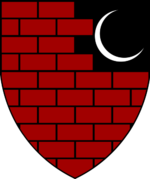East Wall: Difference between revisions
No edit summary |
No edit summary |
||
| Line 1: | Line 1: | ||
[[image:EastWallSymbol.png|The bailiwick symbol of Eastwall|thumb|179x179px]] | [[image:EastWallSymbol.png|The bailiwick symbol of Eastwall|thumb|179x179px]] | ||
'''{{PAGENAME}}''' is a bailiwick of the [[Sovereign Confederation]]. It was formed from a merger between the old bailiwicks of Greenwinter and Nova Lunaris. | '''{{PAGENAME}}''' is a bailiwick of the [[Sovereign Confederation]]. It was formed from a merger between the old bailiwicks of Greenwinter and Nova Lunaris. The southeastern corner is home to eight settled mixed Lunatic and Octoluner families, refugees from southern-Lunaris during the years of the [[Guttuli Protectorate]]. While Nova Lunaris no longer existed as a recognized political state, these families would eventually form an informal council for the community and elected to use their cultural novelty within their adopted homeland as a tourist venue for the wealthy members of Sovereign society. In late 1715, the council signed the Vade Mecum, and petitioned their Speaker in the [[Miþuï]] to grant them recognized governing autonomy within the bailiwick. The request was granted by the turn of the new year, in exchange for signing the Treaty of the Meridionales, which provided an amicable oversight and investment model for the Sovereign legislature's approval. | ||
Revision as of 01:11, 2 January 2023
East Wall is a bailiwick of the Sovereign Confederation. It was formed from a merger between the old bailiwicks of Greenwinter and Nova Lunaris. The southeastern corner is home to eight settled mixed Lunatic and Octoluner families, refugees from southern-Lunaris during the years of the Guttuli Protectorate. While Nova Lunaris no longer existed as a recognized political state, these families would eventually form an informal council for the community and elected to use their cultural novelty within their adopted homeland as a tourist venue for the wealthy members of Sovereign society. In late 1715, the council signed the Vade Mecum, and petitioned their Speaker in the Miþuï to grant them recognized governing autonomy within the bailiwick. The request was granted by the turn of the new year, in exchange for signing the Treaty of the Meridionales, which provided an amicable oversight and investment model for the Sovereign legislature's approval.
In 1712, the population was 929,873
